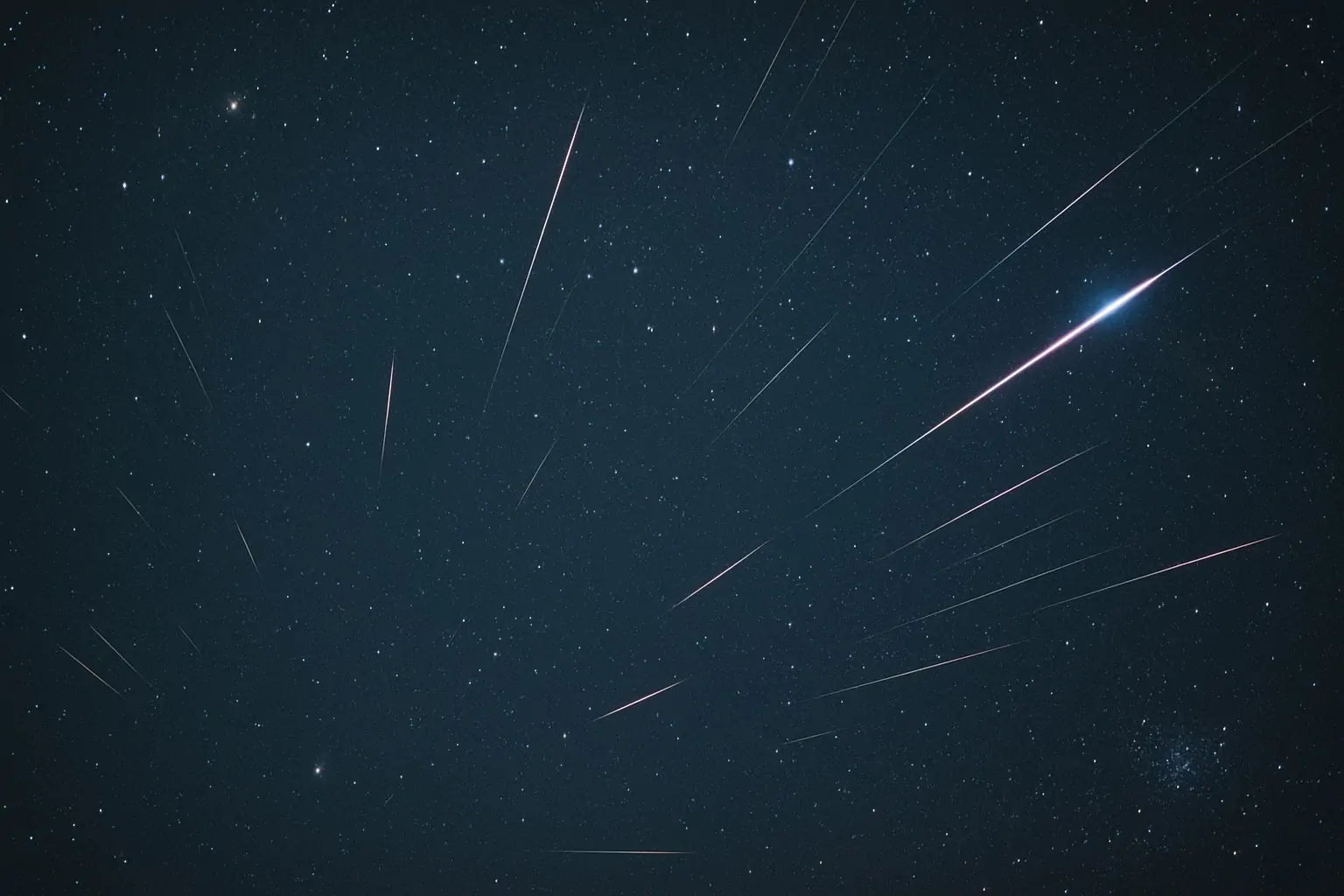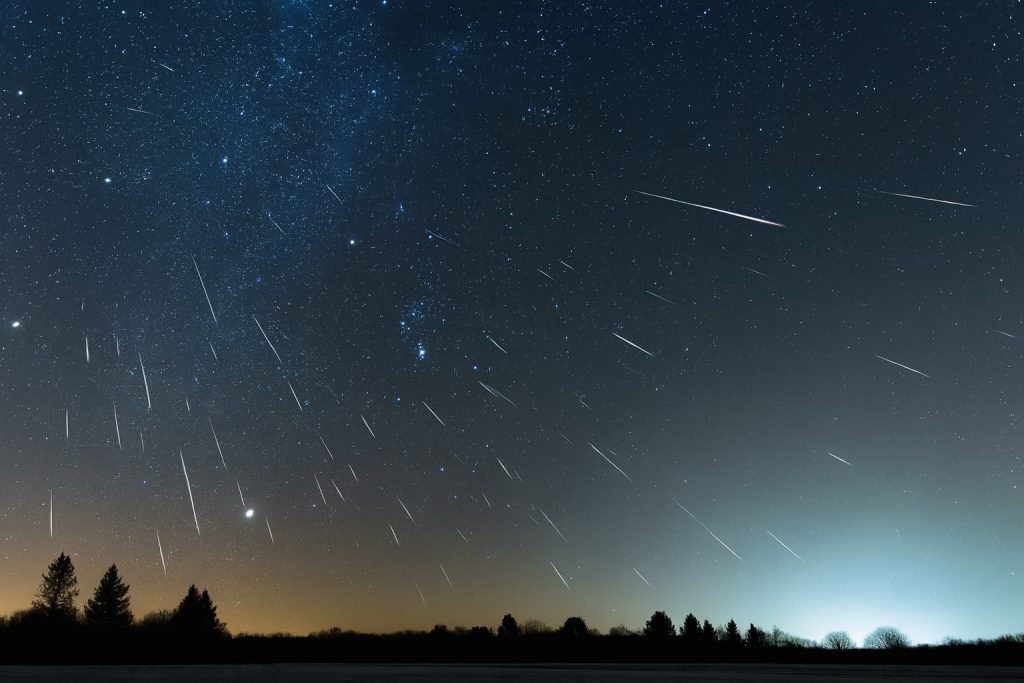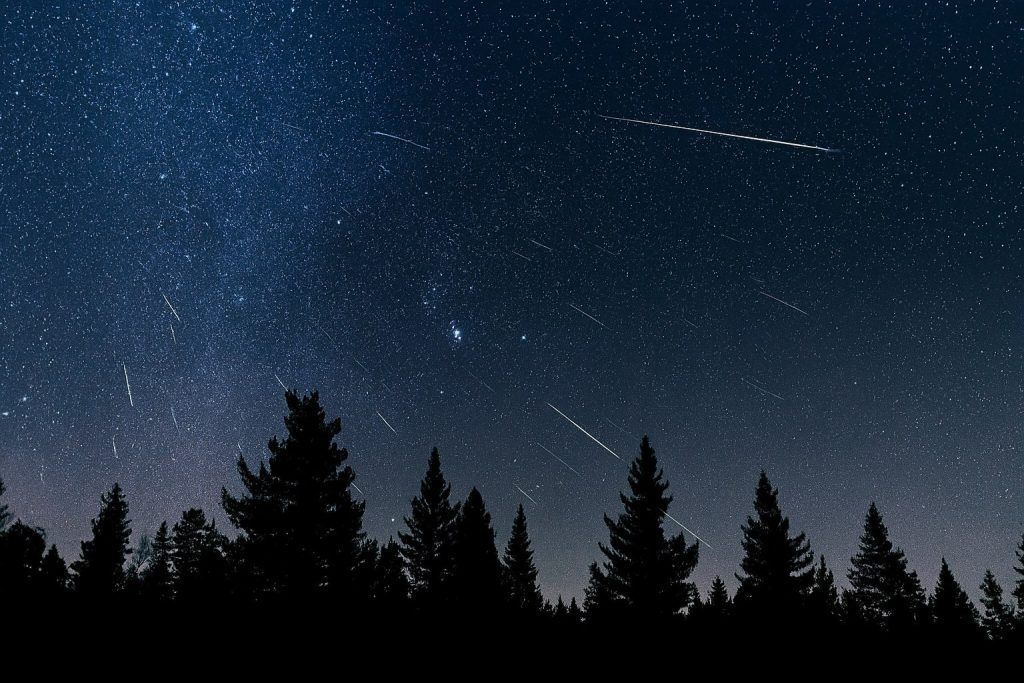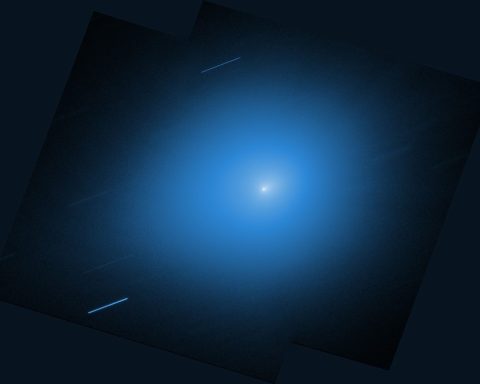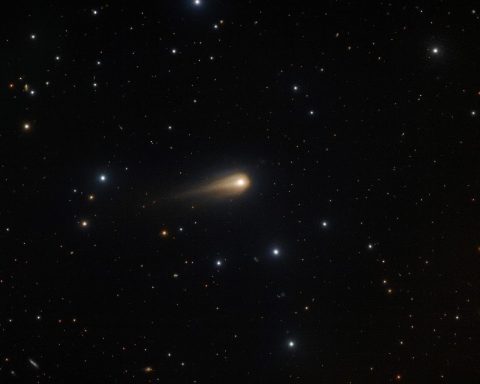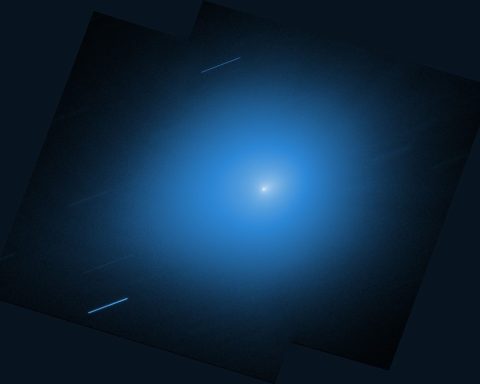- The Taurid meteor showers peak with the Southern Taurids around November 5 and the Northern Taurids around November 9, 2025, in a year noted for a Taurid “swarm” of larger meteoroids.
- The Leonid meteor shower peaks on the night of November 16–17, 2025, under a ~9% illuminated Moon, offering about 15 meteors per hour and some of the fastest at ~70 km/s.
- November 5, 2025, hosts the Beaver Moon full Moon, the brightest full Moon of 2025 and about 7–8% larger than average, which can flood the sky with light.
- There are no solar or lunar eclipses in November 2025; the eclipse season ended with the September events, and the next eclipse occurs in 2026.
- Venus leaves the predawn sky with a superior conjunction on November 9, 2025, shining at magnitude −4 in the morning sky before disappearing until it reappears as an evening star later.
- Mercury transitions from evening to morning sky this month, with inferior conjunction on November 20, 2025, and a return to dawn visibility in late November; the best morning apparition is in December.
- Jupiter is a dominant pre-dawn object in November 2025 (magnitude about −2.5), rising after midnight in Gemini and set to be brightest in late December prior to its 2026 opposition on January 10.
- Uranus reaches opposition on November 21, 2025, at about magnitude +5.6 in Taurus near the Pleiades, visible with binoculars and showing a disk 3–4 arcseconds.
- Saturn, at magnitude around +0.6 in Aquarius, remains well placed after its September 2025 opposition, with Titan undergoing occultation on November 14 and a transit across Saturn’s disk on November 22.
- Comet highlights for November 2025 include 24P/Schaumasse passing in front of the Beehive Cluster (M44) in Cancer from November 8–11; C/2025 A6 Lemmon near perihelion around November 8 with potential magnitude 3–4; 210P/Christensen reaching perihelion on November 22 with around magnitude 8; and the interstellar 3I/ATLAS (C/2025 N1) beginning to be observable in late November with brightness uncertain.
November 2025 is brimming with celestial events that will delight skywatchers. From fireball-spitting meteor showers and a record-breaking supermoon to bright planets on parade and even a visiting comet, the night sky offers plenty of reasons to look up. Below is your comprehensive guide – complete with expert insights and key dates – to all the notable skywatch alerts this month.
Meteor Showers: Fireballs and Falling Stars
Two major meteor showers reach their peak in November 2025, promising shooting stars (and a few fireballs) for patient observers:
- Taurid Meteor “Fireballs” – Early November: The Taurids are a pair of long-lasting showers (Southern and Northern Taurids) active throughout October and into November. They are notorious for producing occasional bright fireballs. In 2025, the Southern Taurids are expected to peak around November 5 and the Northern Taurids around November 9, though both “ramble along” without sharp peaks [1]. Normally each branch only yields ~5 meteors per hour (about 10 combined during the overlap) under dark skies [2] [3]. This year is considered a Taurid “swarm” year, when an enhanced cluster of larger meteoroids may increase the fireball count [4]. However, sky conditions are less than ideal: the full Moon on November 5 coincides with the Southern Taurids’ peak, and an 83% waning moon lights the sky for the Northern Taurids’ peak around November 8-12 [5]. The bright moonlight will wash out many faint meteors in 2025 [6]. Still, keep an eye out for Taurid fireballs – the Taurids “are rich in fireballs” and have shown a seven-year periodicity in producing spectacular fireballs (notably in 2008, 2015, and 2022) [7]. Even with lunar glare, a brilliant Taurid fireball streaking across the midnight sky can be an unforgettable sight.
- Leonid Meteor Shower – Mid-November: The Leonids grace the sky each November and are famous for the historic meteor storms they produced in the past (most famously in 1833, 1866, 1966, and more recently 1999-2002). These outbursts occur when Earth passes through dense debris from Comet 55P/Tempel–Tuttle, which orbits the Sun every ~33 years [8]. No meteor storm is expected this year – the next potential Leonid “bonanza” isn’t due until 2032–33 when the comet returns near perihelion [9]. But the Leonids 2025 should still put on a pleasing show under favorable conditions. Peak activity is predicted for the night of November 16–17, 2025, and fortune smiles on skywatchers: the Moon will be a slim waning crescent (only ~9% illuminated) during the Leonid peak [10]. With dark, moonless skies, observers could see around 15 meteors per hour at the peak [11]. “This year, the peak of the Leonid meteor shower coincides with a slim waning crescent moon, which means dark, moonless skies that could yield about 15 shooting stars per hour,” notes one astronomy writer [12]. Plan to watch after midnight (when Leo rises higher) from a dark location – and you just might catch some of the fastest meteors of any shower (Leonids zip into the atmosphere at ~70 km/s, often leaving lingering trains).
Minor Showers: The Orionids, which peaked in late October, continue their activity into early November but taper off by Nov 12. Another minor shower, the Alpha Monocerotids, peaks around November 21. Normally this is a very weak shower (only a few meteors per hour) with short-lived outbursts observed only a few times in history (e.g. a burst of ~400 meteors/hour in 1995 for about 30 minutes). No outburst is expected in 2025, according to experts [13]. The good news is the Moon will be new on Nov 20, so if any “unicorn” meteors (from Monoceros, the Unicorn constellation) do occur, even faint ones won’t be hidden by moonlight. It’s a long shot – but the dark skies on Nov 21–22 mean any surprise meteor activity would be readily visible.
November’s Supermoon: The Brightest since 2019
Mark your calendar for November 5, 2025, when the Full Moon – traditionally called the Beaver Moon – rises shortly after sunset. This will be a supermoon, and not just any supermoon: it’s the biggest and brightest full Moon of 2025, appearing about 7–8% larger than average. In fact, November’s full Moon will be the brightest since 2019 [14]. (2025 features three consecutive supermoons in October, November, and December, with the November one being the most impressive of the trio [15].)
While the term “supermoon” refers to a full Moon occurring near perigee (the Moon’s closest point to Earth in its orbit), the visual difference is subtle to most observers. Still, many people notice the Full Moon looking especially big and golden when seen low on the horizon at moonrise – an effect enhanced by the Moon illusion. For the full “big Moon” effect, try to catch the Beaver Moon as it is rising on Nov 5 [16]. The dazzling moonlight will brighten the night (to the detriment of meteor observing that week), but it makes for a gorgeous spectacle and great photo opportunities. Just be aware that such a luminous Moon will drown out fainter stars – and that’s why meteor enthusiasts prefer the new moon period later in the month.
(Fun fact: The Beaver Moon gets its folk name from Algonquian traditions, as November was the time to set beaver traps before winter. Under the glow of 2025’s beaver supermoon, you can appreciate why full Moons captivated human imagination and folklore.)
No Eclipses This Month
Unlike October 2025 (which had a partial solar eclipse) or September 2025 (which featured a total lunar eclipse), November 2025 has no major eclipses – neither solar nor lunar. In 2025 there were two lunar eclipses (total eclipses in March and September) and two solar eclipses (partial eclipses in March and September) [17], but the eclipse “season” is over by November. The next eclipse will come in 2026. So, you won’t need your eclipse glasses or telescopes this month – the night sky’s highlights will come from stars, planets, and meteors instead.
(If you’re curious: the most recent eclipse was the partial solar eclipse of September 21, 2025, visible from the South Pacific. Earlier in the fall, on Sept 7, skywatchers in parts of North America enjoyed a beautiful total lunar eclipse as the full Harvest Moon slipped into Earth’s shadow. But November itself is eclipse-free.)
Planetary Alignments and Highlights
Planets abound in November’s skies, with some shifting roles as morning or evening “stars.” Here’s what to look for:
- Venus – From Morning Star to Out of Sight: Venus has been a brilliant “Morning Star” for months, but it’s finally departing the predawn stage. In early November, Venus shines brightly in the east before dawn, rising about 1½ hours before sunrise for mid-northern latitudes [18]. It’s by far the brightest planet (magnitude –4), so you can’t miss it if you’re up early. However, Venus is trekking back toward the Sun from our viewpoint; by the end of November it will be lost in the solar glare and no longer visible (especially for Southern Hemisphere observers) [19] [20]. Enjoy Venus’s dazzling presence early in the month, because it won’t return to view until it re-emerges as an “Evening Star” on the far side of the Sun in a couple of months. (On November 9, Venus will actually reach superior conjunction – passing behind the Sun – which explains why it disappears from view.)
- Mercury – A Blink-and-You-Miss-It Appearance: The innermost planet makes a quick transition this month. Mercury was hovering low in the sunset twilight in late October (it reached greatest eastern elongation on Oct 29). By mid-November it drops out of the evening sky and on November 20 Mercury passes between the Earth and Sun (inferior conjunction). Shortly after that date, Mercury pops into the morning sky. By the final week of November, keen-eyed observers might glimpse Mercury low in the southeast just before sunrise [21]. (Mercury will actually have its best morning apparition in December, becoming brightest and easiest to spot around the first half of December [22] [23], but late November is when to start hunting for it in dawn twilight.) If you want to attempt Mercury, use binoculars and find a location with a clear view of the horizon in the direction of sunrise – and be sure to look only when the Sun is still below the horizon for safety.
- Jupiter – King of the Pre-Dawn Sky: Gas giant Jupiter does not reach opposition at all in calendar 2025 (its next opposition is January 10, 2026) [24], but by late 2025 it’s already becoming a dominant night object. Throughout November 2025, Jupiter is a brilliant morning planet. It rises after midnight and shines high in the south before sunrise, outshining every star (at about magnitude –2.5). By month’s end, Jupiter will be visible by late evening and extremely bright as it heads toward its early-2026 opposition. In fact, Jupiter will be at its brightest for the year during the last week of December 2025 [25], so November is the time when Jupiter’s grandeur really comes into focus in the night sky. Look for Jupiter in the constellation Gemini in the predawn hours – around 4–5 AM it will be nearly 60° high for mid-northern observers [26], gleaming a golden-white. Through a telescope, Jupiter’s cloud bands and moons are a treat in the steady early-morning air. (Notably, Jupiter and Venus had a close conjunction back in August 2025; now Jupiter reigns alone in the morning sky as Venus bows out.)
- Saturn – Evening Ringed Planet:Saturn reached opposition in late September 2025 [27], so it is still well-placed in the evening sky this month. You can find Saturn in the constellation Aquarius, visible in the southeast at nightfall. By mid-evening, Saturn stands about 33° high (as seen from mid-northern latitudes) and due south, making it optimal for telescope viewing [28]. Shining at magnitude ~+0.6, Saturn has a yellowish hue and is relatively easy to spot with the naked eye if you know where to look (use the nearby stars of Capricornus/Aquarius as guides, or a stargazing app). Throughout November, Saturn is visible for most of the night, setting in the pre-dawn hours. It’s a great time to point a telescope at Saturn’s magnificent rings – which are currently nearly edge-on as seen from Earth (in 2025 the rings are very thin, a unique view as Saturn’s ring plane alignment is nearly edge-on to us). Also, if you have a telescope, note that Saturn’s largest moon Titan will undergo some interesting events this month: on Nov 14, Titan will be occulted and then partially eclipsed by Saturn’s shadow, and on Nov 22 Titan will transit in front of Saturn’s disk [29] [30]. These events require a good telescope to observe, but they highlight that even planets present dynamic mini “sky shows” of their own.
- Uranus at Opposition – November 21: Mark Nov 21, 2025 as the best time to observe the distant ice giant Uranus. On that date, Earth passes directly between Uranus and the Sun, placing Uranus at opposition (opposite the Sun in the sky) and at its closest and brightest of the year [31]. Uranus will shine at about magnitude +5.6 [32] [33], right at the edge of naked-eye visibility under excellent dark-sky conditions. In practice, most people will need binoculars or a telescope to easily spot it. Where and when: Uranus lies in the constellation Taurus, not far from the Pleiades cluster. At opposition it rises in the east around sunset and stays up all night [34], reaching its highest point in the south around midnight. If you have a star chart or astronomy app, you can find Uranus’s exact position among the background stars of Taurus. Through binoculars it appears as a tiny star-like point; a telescope at high magnification will reveal a small aquamarine-green disk only ~3–4 arcseconds across [35]. EarthSky.org notes that even at peak brightness, Uranus is barely perceptible to the unaided eye – “at a magnitude +5.6, Uranus shines no more brilliantly than the sky’s faintest visible stars” [36]. So don’t be disappointed if you can’t see it without optical aid. Use binoculars, and you might also glimpse up to four of Uranus’s moons with a modest telescope on a steady night [37]. The thrill here is seeing a planet 1.8 billion miles away – opposition is when Uranus is about 18.5 AU (astronomical units) from Earth [38], or roughly 2.6 light-hours away [39]! Remember, Uranus moves slowly – it reaches opposition about four days later each year [40], and in 2025 that date is Nov 21.
- Neptune: Farther out, Neptune reached opposition in late September 2025 (just two days after Saturn did) [41]. In November, Neptune is an evening object located in Aquarius (near Saturn in the sky). At magnitude ~+7.8, Neptune requires binoculars or a telescope to find. It is observable in the earlier part of the night, highest in late evening. If you have a detailed star chart, you could track Neptune down – but given its faintness, it remains a target mainly for dedicated observers. Still, it’s fun to note that all seven planets (Mercury through Neptune) are technically above the horizon at some point this month; five of them (Mercury, Venus, Jupiter, Saturn, Uranus) are easily observed without a telescope at various times [42] [43].
Tip: Several pretty Moon-planet conjunctions happen in November. For example, around November 2–3, the nearly full Moon will shine near Jupiter in the pre-dawn sky. Later, on November 19–20, look for a delicate crescent Moon at dawn, positioned not far from where Venus and Mercury are emerging (though Venus will be very low by then). These close approaches are harmless line-of-sight coincidences, but they make for lovely visual pairings. Check an online sky calendar for exact dates of the Moon’s encounters with planets and bright stars.
Aurora Alert: Lights in the Sky at Solar Maximum
High-latitude skywatchers should stay alert for the Aurora Borealis (northern lights) and Aurora Australis this month. That’s because the Sun is currently near the peak of its ~11-year activity cycle, Solar Cycle 25. In fact, scientists announced that the Sun likely entered its maximum phase in late 2024, and solar maximum is predicted to continue through at least mid-to-late 2025 [44] [45]. During solar max, the Sun unleashes more frequent solar flares and coronal mass ejections (CMEs), which in turn can spark more frequent and intense auroral displays on Earth.
What does this mean for November 2025? In practical terms, any time a strong solar storm erupts, there’s potential for vivid auroras a day or two later when the charged particles reach Earth. This year has already seen unusually widespread auroras – in fact, experts note that aurora activity often peaks just after the official solar maximum, meaning 2025 and the next couple of years could be an especially exciting time for aurora watchers [46]. Even areas that rarely see the aurora might get lucky during big solar events. (Already during 2025, there have been reports of northern lights dipping into “unusual locations” at lower latitudes on nights of strong geomagnetic storms.)
For November specifically, aurora activity can’t be scheduled in advance – it depends on solar weather. Your best strategy is to keep an eye on space weather alerts from agencies like NOAA’s Space Weather Prediction Center. If a significant CME is headed our way, aurora forecasts will indicate the likelihood of geomagnetic storm conditions (Kp indices) needed for auroras at various latitudes. Typically, the long nights of autumn and winter are prime aurora season in the high latitudes. So if you live in or travel to places like Alaska, Canada, Northern Europe (or Tasmania, New Zealand, and Antarctica down south), be ready. Dark, clear skies away from city lights are essential, and late evening to early morning is often the best time frame for auroral activity. Under a strong solar wind stream, you might see green curtains of light, with occasional reds or purples dancing low on the horizon if you’re at the auroral edge.
“The solar cycle is now in its maximum period… meaning that the next couple of years will likely be an exciting time for aurora watchers as well,” explains Dr. Renate Mauland-Hus, an astrophysicist who studies the northern lights [47]. Even after the Sun’s peak, she notes, the aurora can remain strong. So consider November 2025 an invitation to watch the space weather. A minor G1-class geomagnetic storm can spark auroras visible across northern-tier U.S. states or central Europe; a stronger G2 or G3 storm can push the lights even farther from the poles. Given the elevated solar activity, it’s quite possible at least one such storm will occur this month. If it does, don’t miss the chance to witness the aurora’s ethereal glow – it’s one of nature’s most awe-inspiring sky shows.
Comets and Other Celestial Visitors
November 2025 offers a cornucopia of comet news. Several comets will be gracing the skies – mostly faint ones, but still notable for dedicated observers (and one with historic significance). Here are the comet highlights:
- Periodic Comet 24P/Schaumasse – Photo-Op in Cancer: Comet 24P/Schaumasse won’t reach its brightest until early January 2026 (when it may be around magnitude 8.0) [48], but in November 2025 it has a special encounter: between November 8–11, 2025, this comet will pass directly in front of the Beehive Cluster (Messier 44) in the constellation Cancer [49] [50]. The backdrop of the rich star cluster will make a great target for astrophotographers. Even though the comet itself is not expected to be naked-eye (likely magnitude 8–9 in November, requiring binoculars or a small telescope), seeing a fuzzy comet glow amid the glittering stars of M44 could be a treat. The Beehive Cluster is an open cluster visible in binoculars, and having a comet drift through it is a relatively rare event. Observers with telescopes should also note that 24P/Schaumasse is a short-period comet (orbital period ~8.2 years) discovered in 1911 [51] – so we are observing a regular visitor making another trip around the Sun. Look for Comet Schaumasse in the late night and pre-dawn hours when Cancer rises highest; the comet will appear as a small nebulous patch moving night-to-night against the cluster’s stars.
- Comet C/2025 A6 (Lemmon) – Possible Binocular Comet: This comet was discovered in January 2025 at Mount Lemmon Observatory [52], and by late October and November 2025 it will be making its closest approach to Earth (~0.6 AU on Oct 21) and reaching perihelion (closest to Sun) on November 8, 2025 [53]. Comet “Lemmon” is projected to reach about magnitude 8 at best, meaning it should be visible in binoculars or a small telescope for Northern Hemisphere observers [54]. It will be conveniently placed in the evening sky during this period [55]. There is some cautious optimism that C/2025 A6 could surprise us and brighten even more – possibly up to magnitude ~3–4 if it undergoes a favorable surge near perihelion [56]. (“Comets tend to brighten significantly near perihelion,” the Star Walk astronomy site notes, adding “let’s keep our fingers crossed!” [57].) If it did reach magnitude 3–4, that would make it faintly visible to the naked eye under dark skies. However, such predictions are highly uncertain. For now, assume it will be a binocular object. To find Comet Lemmon, you can use star charts or online trackers – it will be moving through the constellations in the western sky after sunset. By mid-November it sinks lower in twilight. Take a look in early November when it’s higher and before the Moon gets too bright. Even a modest comet in binoculars can be rewarding, appearing as a small fuzzy star with perhaps a hint of a tail on long-exposure images.
- Comet 210P/Christensen – Short-Period Visitor: Another dim binocular comet, 210P/Christensen, reaches its perihelion on November 22, 2025 [58]. This is a short-period comet (5.7-year orbit) that belongs to Jupiter’s family of comets [59]. At the end of November, it might brighten to about magnitude 8.1–8.3 at peak [60], potentially visible in binoculars. However, it will be positioned low in the pre-dawn eastern sky during that time, so viewing will be challenging – essentially right before morning twilight, near the horizon [61]. If you’re an early riser, you could attempt to spot Comet 210P in late November by scanning the east-southeast horizon an hour or so before sunrise (look for updates on its position; it starts the month too close to the Sun to see, then gradually moves into darker sky by month’s end) [62]. Don’t expect a spectacle; this comet is more of interest to comet enthusiasts keeping track of periodic comets. It was discovered in 2003 and is only ~1.7 km in diameter [63], so it’s intrinsically faint.
- Interstellar Interloper – 3I/ATLAS: Perhaps the most intriguing cosmic visitor is Comet 3I/ATLAS (C/2025 N1) – notable for being an interstellar object. This comet, discovered in July 2025 by the ATLAS survey in Chile, is the third confirmed interstellar object (after the famous ‘Oumuamua in 2017 and Comet 2I/Borisov in 2019) [64]. It’s essentially an object from beyond our solar system that is passing through. During late November 2025, Comet 3I/ATLAS will start becoming observable from Earth’s perspective, but here’s the catch: it may not get very bright. Early optimistic models suggested it could reach around magnitude 8, which would put it in range of binoculars [65]. However, more conservative estimates predict a peak only around mag 12 – meaning you’d need at least an 8-inch (20 cm) telescope and dark skies to see it [66]. By late November, 3I/ATLAS will emerge in the dawn sky (it has a perihelion on Oct 29 but was behind the Sun then) and slowly brighten through December. Even if it remains telescopic, this comet is a scientific highlight: it’s a rare chance to observe material from another star system. Astronomers worldwide will be studying its composition and behavior to learn how it compares to local comets. If you have access to a telescope or live near an observatory offering public nights, ask about 3I/ATLAS – you might get to “meet” an interstellar visitor! Just temper expectations for its brightness. The fact that it’s out there, potentially up to tens of kilometers in size [67], and not bound to the Sun, is awe-inspiring in its own right.
Bottom line: While no “Great Comet” is predicted for November 2025, there is plenty of comet activity to keep things interesting. At least two comets (Lemmon and Christensen) could reach binocular visibility around magnitude 8 [68] [69], and Comet 24P/Schaumasse provides a unique photo opportunity as it glides past a star cluster [70]. Meanwhile, the arrival of an interstellar comet 3I/ATLAS has astronomers abuzz, even if it’s a faint target. Be sure to check astronomy websites or apps for finder charts if you plan to seek any of these out – comets move from night to night against the starry background.
Space Station and Satellite Events
Human-made celestial “stars” will make appearances too:
- ISS Flyovers: The International Space Station continues its 90-minute orbits around Earth and will be visible as a bright, fast-moving star on many nights (or early mornings) this month. The visibility of ISS passes depends on your location – roughly speaking, there are periods of a couple weeks when the ISS is visible in the evening sky, and periods when it’s visible before dawn. In November 2025, mid-northern latitude observers (like those in the continental U.S. or Europe) will have morning visibility of the ISS in the first part of the month and evening visibility later in the month (this alternates as the ISS’s orbit geometry shifts). To know exactly when to see the ISS flying over your town, use NASA’s “Spot the Station” online tool or app. When it does pass overhead, the ISS is very bright (often magnitude –2 to –4, rivaling Venus) and takes about 4–6 minutes to cross the sky. It does not blink (airplane lights blink; the ISS shines with steady reflected sunlight), and it moves briskly from one horizon to the other. Get the kids and family outside to wave – there are usually 7 crew members aboard who might be looking down as you look up!
- Crew Launch to the ISS: In fact, November 2025 will see a crewed launch to the space station. A Russian Soyuz rocket (Soyuz MS-28 mission) is scheduled to lift off in November from Baikonur Cosmodrome, Kazakhstan, carrying a three-person crew to the ISS [71]. The crew includes NASA astronaut Chris Williams on his first spaceflight, alongside Roscosmos cosmonauts Sergey Kud-Sverchkov and Sergei Mikaev [72]. They will join Expedition 74 aboard the ISS and stay for about eight months. While the exact launch date is to be announced (as of this writing, it’s a “NET [No Earlier Than] November” plan), if it launches at night local time, observers in parts of Asia or Europe might actually see the Soyuz rocket’s bright flame for a brief moment after launch, and possibly even the spacecraft as a fast-moving dot chasing the ISS, depending on trajectories. Even if you’re not near the launch, it’s exciting to know that humans are heading to orbit this month. The Soyuz rendezvous and docking will be covered on NASA TV. About two days after launch, you might catch a subtle change in the pattern of ISS passes – that’s when the new Soyuz has docked and the crew is onboard, bringing the ISS crew complement up and eventually allowing previous members to rotate home in December.
- Artificial Satellite Trains: Apart from the ISS, many other satellites pepper the night sky. In recent years, SpaceX Starlink satellites have become noticeable, especially shortly after launch when they appear in a tight “train” of bright dots moving in line. SpaceX has frequent Starlink launches (as many as one per week globally), and a couple are likely in November 2025. If you happen to be outside a day or two after a launch, shortly after sunset or before sunrise, you might witness a string of pearl-like lights crossing the sky. They can be an intriguing sight (though they’ve also raised concerns among astronomers). These satellites dim as they spread out and raise their orbits, so the “train” effect is temporary. If you catch one by chance, now you’ll know what it is. (And if you want to purposely spot one, websites like Heavens-Above list predicted passes of Starlink groups.)
- Other Notable Launches: November 2025 is busy in spaceflight. Besides the crewed Soyuz mission, there may be multiple uncrewed rocket launches (for satellites, probes, etc.) this month. While most launches aren’t directly observable unless you live near a launch site, rocket launches sometimes create spectacular sky phenomena. For instance, a rocket launched shortly after sunset or before sunrise can produce a glowing high-altitude exhaust plume – a phenomenon sometimes called a “space jellyfish” – visible for hundreds of miles. Keep an eye on space news for any high-profile launches from facilities like Cape Canaveral, Vandenberg, or Baikonur. As an example, SpaceX has been targeting a record number of launches in 2025, so any evening launch could treat residents of Florida or California to a beautiful twilight exhaust display.
Finally, don’t forget to simply enjoy the night sky itself. November brings longer nights in the Northern Hemisphere, and the rich winter starfields begin to come into view. Orion, Taurus, and Gemini – accompanied by the bright stars Rigel, Betelgeuse, Aldebaran, and the close-knit Pleiades – all adorn the night from late evening onward. This stellar backdrop forms the stage on which November 2025’s special events play out. Whether it’s catching a wishful Leonid meteor, marveling at the supermoon casting silvery light over the landscape, or tracking down the pale green disk of distant Uranus, there’s something for everyone to experience.
In summary, November 2025 is an astronomical extravaganza: meteor showers (albeit met with some moonlight obstacles), a record-bright full Moon [73], planets galore (with Venus bowing out and Uranus taking center stage at opposition [74]), heightened auroral activity thanks to a feisty Sun [75], and several comets – including one from beyond our solar system – gracing our skies. As NASA’s monthly skywatching advisors often say, “Keep looking up!” Clear skies and happy observing.
Sources:
- EarthSky.org – “Taurid meteors in 2025: All you need to know” (Deborah Byrd, Nov. 2, 2025) [76] [77] [78]
- American Meteor Society – Meteor Shower Calendar 2025 [79] [80]; Leonids 2025 info [81] [82]
- Space.com – “15 must-see skywatching events in 2025” (J. Carter, Jan. 2, 2025) [83] [84] [85]
- StarWalk (Vito Technology) – “Upcoming Comets” (accessed 2025) [86] [87] [88] [89]
- Sky at Night Magazine (BBC) – “Visible planets guide 2025” (Pete Lawrence) [90] [91] [92] [93]
- TimeandDate.com – “Solar Maximum Makes 2025 a Great Year for Northern Lights” (Dr. R. Mauland-Hus, 2025) [94] [95]
- NASA Science / EclipseWise – Eclipse listings for 2025 (Fred Espenak) [96]
- Space.com – Space Calendar 2025 (launch and mission schedule) [97]
References
1. earthsky.org, 2. earthsky.org, 3. earthsky.org, 4. www.amsmeteors.org, 5. www.amsmeteors.org, 6. earthsky.org, 7. earthsky.org, 8. www.space.com, 9. www.space.com, 10. www.amsmeteors.org, 11. www.space.com, 12. www.space.com, 13. starwalk.space, 14. www.space.com, 15. www.space.com, 16. www.space.com, 17. www.eclipsewise.com, 18. www.skyatnightmagazine.com, 19. earthsky.org, 20. www.skyatnightmagazine.com, 21. www.skyatnightmagazine.com, 22. www.farmersalmanac.com, 23. www.space.com, 24. www.space.com, 25. www.space.com, 26. www.skyatnightmagazine.com, 27. www.rmg.co.uk, 28. www.skyatnightmagazine.com, 29. www.skyatnightmagazine.com, 30. www.skyatnightmagazine.com, 31. starwalk.space, 32. starwalk.space, 33. earthsky.org, 34. earthsky.org, 35. earthsky.org, 36. earthsky.org, 37. earthsky.org, 38. earthsky.org, 39. earthsky.org, 40. earthsky.org, 41. www.rmg.co.uk, 42. science.nasa.gov, 43. starwalk.space, 44. www.timeanddate.com, 45. www.timeanddate.com, 46. www.timeanddate.com, 47. www.timeanddate.com, 48. www.timeanddate.com, 49. www.skyatnightmagazine.com, 50. starwalk.space, 51. starwalk.space, 52. starwalk.space, 53. starwalk.space, 54. starwalk.space, 55. starwalk.space, 56. starwalk.space, 57. starwalk.space, 58. starwalk.space, 59. starwalk.space, 60. starwalk.space, 61. starwalk.space, 62. starwalk.space, 63. starwalk.space, 64. starwalk.space, 65. starwalk.space, 66. starwalk.space, 67. starwalk.space, 68. starwalk.space, 69. starwalk.space, 70. starwalk.space, 71. www.space.com, 72. www.space.com, 73. www.space.com, 74. earthsky.org, 75. www.timeanddate.com, 76. earthsky.org, 77. earthsky.org, 78. earthsky.org, 79. www.amsmeteors.org, 80. www.amsmeteors.org, 81. www.amsmeteors.org, 82. www.amsmeteors.org, 83. www.space.com, 84. www.space.com, 85. www.space.com, 86. starwalk.space, 87. starwalk.space, 88. starwalk.space, 89. starwalk.space, 90. www.skyatnightmagazine.com, 91. www.skyatnightmagazine.com, 92. www.skyatnightmagazine.com, 93. www.skyatnightmagazine.com, 94. www.timeanddate.com, 95. www.timeanddate.com, 96. www.eclipsewise.com, 97. www.space.com
